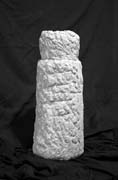Select a site alphabetically from the choices shown in the box below. Alternatively, browse sculptural examples using the Forward/Back buttons.
Chapters for this volume, along with copies of original in-text images, are available here.
Object type: Shaft
Measurements: H. 59 cm (23.25 in); H. of cup only 13 cm (5.5 in); Diam. at top 21 cm (8.5 in); at base 23 cm (9 in); Circumference 79 cm (31 in)
Stone type: Pale yellowish-grey (10YR 8/1–2) oolite with coarse shelly layers showing low-angle cross-bedding along the length of the shaft. Oolites are 0.3 to 0.6mm diameter, shell fragments up to 10mm, some recognisable as ostreid. Taynton stone
Plate numbers in printed volume: Pls. 438-43
Corpus volume reference: Vol 7 p. 213-4
(There may be more views or larger images available for this item. Click on the thumbnail image to view.)
The shaft, which tapers to a cup at the top, is rounded at the 'front' and flattened at the back and there are clear signs of the tool marks for hollowing out the cup on the interior. The surface ornament on the shaft goes right up to the rim, and where it survives best has the appearance of hollowed petals. Elsewhere the ornament on the shaft is difficult to decipher, and consists of deep grooves which encircle the shaft at the top but nearer the base are diagonal and in one place have the appearance of interlace. Part of this surface detail has been cut back towards the flattened plain side of the shaft, which bears the signs of deep grooving and is smoothly dressed. In the base of the shaft is a dowel hole (diam. 4.5 cm / 1.75 in) filled with lead and off centre.
This may be a Roman shaft which has been reshaped and hollowed into a bowl at the top. This view is supported by the fact that there is Roman material in the area and it is common Roman practice to link stones with lead, whilst the recutting is not only to be seen on the surface of the stone but in the fact that the dowel at the base is not centrally placed. The rough surface texturing of this piece is neither diagnostic of Roman nor Anglo-Saxon work. It is possible however that this was a Roman shaft reused as a holy water stoup.



